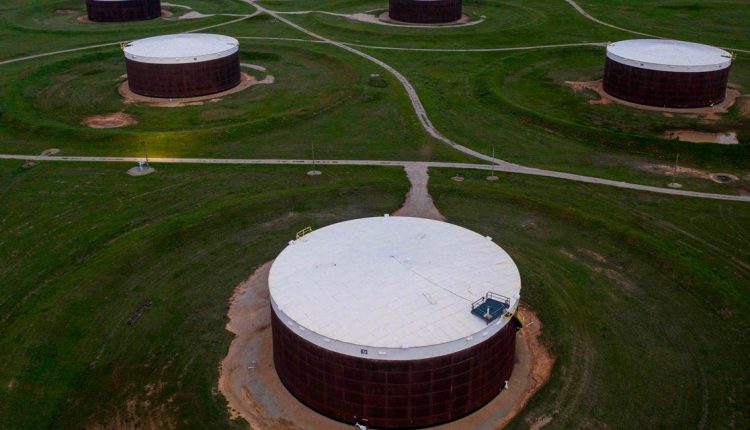Oil futures rose Wednesday, building on 2023 highs, on continued concerns over tight supplies.
Gains for oil prices come despite the latest update on U.S. petroleum supplies, with the Energy Information Administration reporting a weekly rise in domestic crude inventories following four consecutive weeks of declines.
Price action
-
West Texas Intermediate crude for October delivery
CL00,
+0.15% CLV23,
+0.15%
rose 16 cents, or 0.2%, to $89.02 a barrel on the New York Mercantile Exchange. It was trading at $88.78 shortly before the EIA supply data. -
November Brent
BRN00,
+0.16% BRNX23,
+0.16%
was up 13 cents, or 0.2%, at $88.97 a barrel on ICE Futures Europe. -
October gasoline
RBV23,
+0.16%
traded at $2.7071 a gallon, down 0.8%, while October heating oil
HOV23,
+2.82%
added 1.8% to $3.3891 a gallon. -
October natural gas
NGV23,
-1.79%
fell nearly 0.1% t $2.741 per million British thermal units.
Risk of global supply deficit
In its monthly report, the Paris-based International Energy Agency forecast a “substantial market deficit” in the fourth quarter.
It said that cuts from Saudi Arabia and other members of the Organization of the Petroleum Exporting Countries have taken 2.5 million barrels a day of crude off the market since January. The cuts have largely been offset by record supply coming from the U.S. and Brazil, with non-OPEC supply up 1.9 million barrels a day.
But the decision by Saudi Arabia and Russia to cut supplies by a combined 1.3 million barrels a day through year-end means the market is now likely to see a deficit of about 1.1 million barrels a day through the fourth quarter, the IEA said.
The IEA’s demand projection of year-on-year growth at 2.2 million barrel a day lies somewhere in the middle between the Energy Information Administration’s 1.8 million barrel a day forecast and OPEC’s 2.4 million barrels a day forecast, StoneX’s Kansas City energy team, led by Alex Hodes, wrote in Wednesday’s newsletter, ahead of the EIA supply data.
The IEA report comes after OPEC’s monthly update on Tuesday left forecasts for supply growth in 2023 and 2024 unchanged.
“On balance, the absence of sizable downward revisions to global oil demand over the next two years, despite recession risks, helped the oil market power on to new
highs” for the year, analysts at Sevens Report Research wrote in Wednesday’s newsletter.
Futures prices have become “overextended to the upside and are in technically overbought territory on the daily time frame charts, leaving the market susceptible to a profit-taking pullback in what is otherwise a still clearly upwardly trending energy market,” they said.
Data released Wednesday showed that U.S. consumer prices climbed by 0.6% in August — the biggest increase in 14 months — largely because of higher oil prices.
Over in Libya, there are “growing concerns over potential supply disruptions due to catastrophic flooding,” said Stephen Innes, managing partner at SPI Asset Management, in commentary emailed overnight.
“The severe flooding in Libya, which has caused damage to numerous ports and infrastructure, has thrown into disarray the country’s ability to export oil,” he said.
U.S. supply update
Also on Wednesday, the Energy Information Administration reported that U.S. commercial crude inventories rose by 4 million barrels for the week ended Sept. 8. That was the first weekly rise reported by the EIA in five weeks.
On average, analysts expected a crude inventory decline of 1 million barrels, according to a survey conducted by S&P Global Commodity Insights. The American Petroleum Institute late Tuesday said crude inventories rose by 1.2 million barrels last week, according to a source citing the figures.
U.S. crude inventories have “yielded a solid build despite refining activity increasing,” said Matt Smith, lead oil analyst, Americas, at Kpler, in emailed commentary. Oil inventories at the Nymex delivery hub at Cushing, Okla., dropped to their lowest level this year, due to much higher net imports, he said.
Crude stocks at the Cushing, Okla., Nymex delivery hub down by 2.4 million barrels for the week, the EIA said, while total U.S. petroleum production rose by 100,000 barrels to 12.9 million barrels a day.
The EIA report also revealed supply increases of 5.6 million barrels for gasoline and 3.9 million barrels for distillates. Analysts polled by S&P Global Commodity Insights had forecast a weekly inventory decline of 1.4 barrels for gasoline, while distillate supplies were expected to be flat for the week.
Read the full article here

